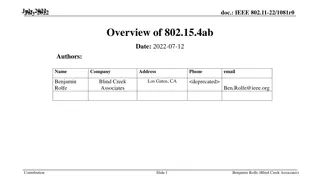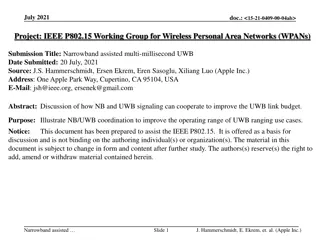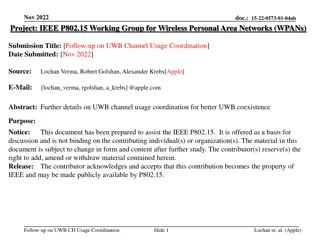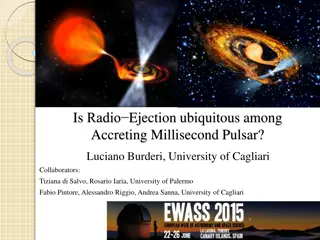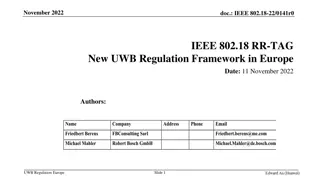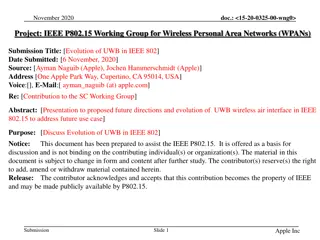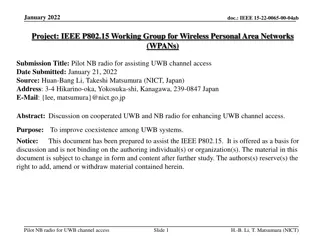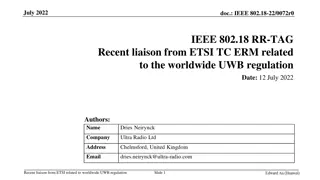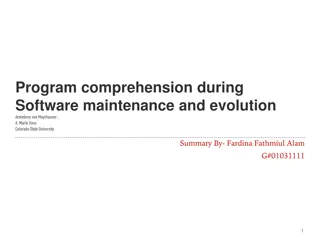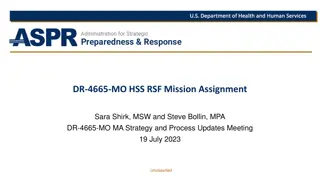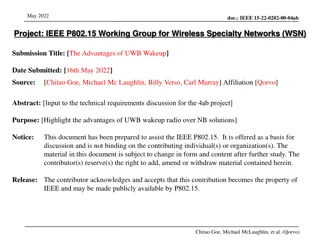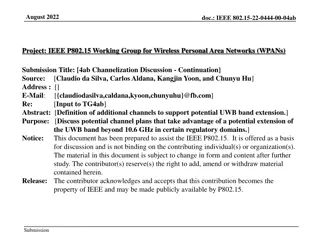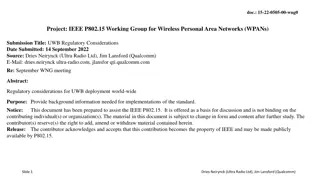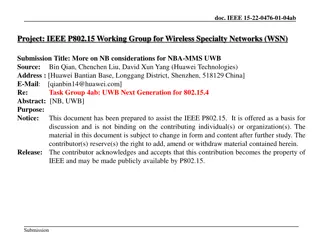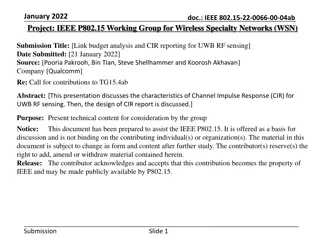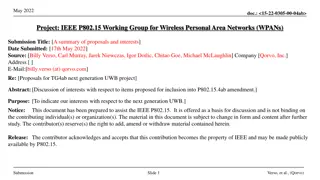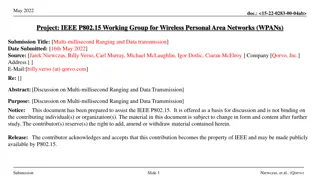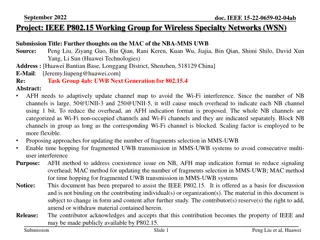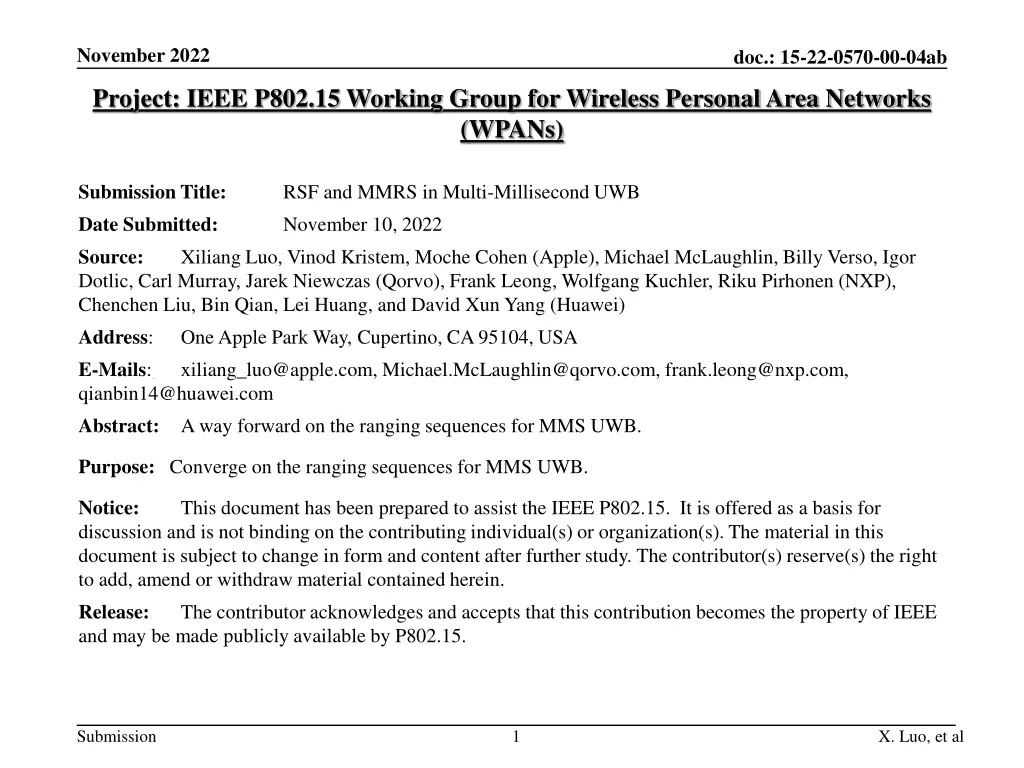
Advanced Ranging Sequences for Multi-Millisecond UWB Technology
Explore the innovative advancements in Multi-Millisecond Ultra-Wideband (UWB) technology through the convergence on ranging sequences for improved integrity, accuracy, and reliability. Enhancements include interference mitigation, high throughput data safeguards, coexistence improvements, and support for diverse use cases such as high-integrity ranging and low-latency streaming. This document outlines the proposed solutions and objectives to elevate UWB capabilities for various applications.
Download Presentation

Please find below an Image/Link to download the presentation.
The content on the website is provided AS IS for your information and personal use only. It may not be sold, licensed, or shared on other websites without obtaining consent from the author. If you encounter any issues during the download, it is possible that the publisher has removed the file from their server.
You are allowed to download the files provided on this website for personal or commercial use, subject to the condition that they are used lawfully. All files are the property of their respective owners.
The content on the website is provided AS IS for your information and personal use only. It may not be sold, licensed, or shared on other websites without obtaining consent from the author.
E N D
Presentation Transcript
November 2022 doc.: 15-22-0570-00-04ab Project: IEEE P802.15 Working Group for Wireless Personal Area Networks (WPANs) Submission Title: Date Submitted: Source: Dotlic, Carl Murray, Jarek Niewczas (Qorvo), Frank Leong, Wolfgang Kuchler, Riku Pirhonen (NXP), Chenchen Liu, Bin Qian, Lei Huang, and David Xun Yang (Huawei) Address: One Apple Park Way, Cupertino, CA 95104, USA E-Mails: xiliang_luo@apple.com, Michael.McLaughlin@qorvo.com, frank.leong@nxp.com, qianbin14@huawei.com Abstract: A way forward on the ranging sequences for MMS UWB. RSF and MMRS in Multi-Millisecond UWB November 10, 2022 Xiliang Luo, Vinod Kristem, Moche Cohen (Apple), Michael McLaughlin, Billy Verso, Igor Purpose: Converge on the ranging sequences for MMS UWB. Notice: discussion and is not binding on the contributing individual(s) or organization(s). The material in this document is subject to change in form and content after further study. The contributor(s) reserve(s) the right to add, amend or withdraw material contained herein. Release: The contributor acknowledges and accepts that this contribution becomes the property of IEEE and may be made publicly available by P802.15. This document has been prepared to assist the IEEE P802.15. It is offered as a basis for Submission 1 X. Luo, et al
November 2022 doc.: 15-22-0570-00-04ab PAR Objective Proposed Solution (how addressed) Safeguards so that the high throughput data use cases will not cause significant disruption to low duty-cycle ranging use cases Interference mitigation techniques to support higher density and higher traffic use cases Other coexistence improvement Periodicity-Division Multiple Access Backward compatibility with enhanced ranging capable devices (ERDEVs) Improved link budget and/or reduced air-time MMS Additional channels and operating frequencies Improvements to accuracy / precision / reliability and interoperability for high-integrity ranging Reduced complexity and power consumption MMS for high-integrity ranging Hybrid operation with narrowband signaling to assist UWB NBA-MMS Enhanced native discovery and connection setup mechanisms Sensing capabilities to support presence detection and environment mapping Low-power low-latency streaming Higher data-rate streaming allowing at least 50 Mbit/s of throughput Support for peer-to-peer, peer-to-multi-peer, and station-to- infrastructure protocols Infrastructure synchronization mechanisms Submission 2 X. Luo, et al
November 2022 doc.: 15-22-0570-00-04ab Definitions A multi-millisecond (MMS) UWB packet consists of a number of fragments of one of the following types Ranging sequence fragment (RSF) carries multi-millisecond ranging sequence (MMRS) good cross-correlation over long accumulation a large set of available sequences Ranging integrity fragment (RIF) carries 4z waveform for ranging integrity e.g. STS waveform Submission Slide 3 X. Luo, et al
November 2022 doc.: 15-22-0570-00-04ab Illustration of MMS Packets NB OR 1~2 ms 1ms (X-2) ms (1+Z) ms 1ms (Y-2) ms S Y N C S F D RSF 1 RSF 2 RSF X RIF 1 RIF 2 RIF Y UWB Z = {0, 1} MMRS MMRS STS STS MMRS MMRS Same sequences Different STS sequences for integrity Submission Slide 4 X. Luo, et al
November 2022 doc.: 15-22-0570-00-04ab Way Forward on MMRS 16 length-128 multi-millisecond ranging sequences (MMRS) based on complementary sets are introduced for MMS UWB more than 30dB cross-correlation suppression could be realized with zero relative CFO further cross-correlation suppression as relative CFO gets larger periodicity division multiple access through flexible & natural insertion of gaps MMRS without gap before spreading: [A, B], where A and B are of length 64 MMRS with gap before spreading: [A, G, B, G], where the gap G contains 0~64 zeros spreading factor L=4 mean PRF from 62.4 to 124.8 MHz a proposed set of 16 MMRSs are listed in the following slide - - - - - - - MMRS based on 4z Ipatov sequences of length 91 or 127 spreading factor L=4 8 length-91 Ipatov sequences for mean PRF of 111.09 MHz 16 length-127 Ipatov sequences for mean PRF of 62.89 MHz - - - Submission Slide 5 X. Luo, et al
November 2022 doc.: 15-22-0570-00-04ab 16 MMRSs based on Complementary Sets 1. +-++-++++-+++---+-++-+++-+---++++-++-++++-+++----+--+---+-+++--- +-++-++++-+++---+-++-+++-+---+++-+--+----+---++++-++-+++-+---+++ 2. +--++--+++----+++-+--+-++++++++++-+-+-+-++++----+--+-++-++--++-- +--++--+++----+++-+--+-+++++++++-+-+-+-+----++++-++-+--+--++--++ 3. +--++--+-+-++-+-++++++++--++++--+--+-++--+-+-+-+++++------++--++ +--++--+-+-++-+-++++++++--++++---++-+--++-+-+-+-----++++++--++-- 4. +---+----+---+--+----++++-++-+--+----+++-+--+-+++---+---+-+++-++ +---+----+---+--+----++++-++-+---++++---+-++-+---+++-+++-+---+-- 5. +----++++-+++-+++---+---+-++-+--+----++++-+++-++-+++-+++-+--+-++ +----++++-+++-+++---+---+-++-+---++++----+---+--+---+---+-++-+-- 6. ++--+-+------++---++-+-+-----++---++-+-++++++--+--++-+-+-----++- ++--+-+------++---++-+-+-----++-++--+-+------++-++--+-+-+++++--+ 7. ------+++-+--++-++--++++-++-+-+-------+++-+--++---++----+--+-+-+ ++++++---+-++--+--++----+--+-+-+------+++-+--++---++----+--+-+-+ 8. -----++------++---++-+-+++--+-+------++-+++++--+--++-+-+--++-+-+ +++++--++++++--+++--+-+---++-+-+-----++-+++++--+--++-+-+--++-+-+ 9. --++-++------+-+++---++-----+-+------+-+--++-++-++++-+-+--+++--+ ++--+--++++++-+---+++--+++++-+-+-----+-+--++-++-++++-+-+--+++--+ 10. -+---+---+++-++++-++-+---++++----+--+-++-++++---+-+++-++-+++-+++ +-+++-+++---+----+--+-+++----+++-+--+-++-++++---+-+++-++-+++-+++ 11. -+---+--+-++-+---++++---+---+----+---+---+--+-++-++++----+++-+++ +-+++-++-+--+-+++----+++-+++-+++-+---+---+--+-++-++++----+++-+++ 12. -+-++-+----------++--++---++++---++-+--+--++--++-+-+-+-+----++++ +-+--+-++++++++++--++--+++----++-++-+--+--++--++-+-+-+-+----++++ 13. -++--++-++----++-+-++-+-+++++++++-+-+-+-----+++++--+-++---++--++ +--++--+--++++--+-+--+-+--------+-+-+-+-----+++++--+-++---++--++ 14. +--++--+-+-++-+-++++++++--++++--+--+-++--+-+-+-+++++------++--++ -++--++-+-+--+-+--------++----+++--+-++--+-+-+-+++++------++--++ 15. +--+----+--+-----+-+++--+-+---++-++-+++++--+----+-+---+++-+---++ -++-++++-++-+++++-+---++-+-+++---++-+++++--+----+-+---+++-+---++ 16. ++---+-+----+--+--+++-+-----+--+--+++-+-++++-++---+++-+-----+--+ --+++-+-++++-++-++---+-+++++-++---+++-+-++++-++---+++-+-----+--+ Submission Slide 6 X. Luo, et al
November 2022 doc.: 15-22-0570-00-04ab Appendix Submission Slide 7 X. Luo, et al
November 2022 doc.: 15-22-0570-00-04ab MMRS Generation from Seeds [?] + + + ?? ?? length 2? + + + + + [?] + X X X ?0 ?? ?? 1 ?1 - - - ?0 ?? 1 ?1 - - #Stages: Delay Vector: ? = 6 ? ?0,?1, ,?5, ?? {20,21, ,25}, ? = 0, ,5 ??+1 2 5 2? - - Seed: Seed = ?=0 Time Reversal Vector: - ??= ?? when ??= 0. When ??= 1, ?? is time-reversed in the final Golay pair, i.e., ??= ?2? 1 ?,? = 0, ,2? 1 - ??= ?? when ??= 0. When ??= 1, ?? is time-reversed in the final Golay pair, i.e., ??= ?2? 1 ?,? = 0, ,2? 1 Final Golay pair as MMRS: [??,??, ,??? ?,??,??, ,??? ?] ? [??,??], ??,?? {0,1} - Note-1: the above structure could be exploited for efficient construction. Note-2: we propose to specify the exact bit patterns in the 16 MMRSs explicitly Submission Slide 8 X. Luo, et al
November 2022 doc.: 15-22-0570-00-04ab Seeds for the 16 MMRSs Sequence # Seed Delay Vector: D Time Reversal Vector:[Ra, Rb] 58 [1 2 4 8 16 32] [0, 0] 1 46 [1 8 4 16 2 32] [0, 0] 2 50 [1 16 2 8 4 32] [0, 0] 3 56 [1 2 8 16 4 32] [0, 0] 4 52 [1 2 8 4 16 32] [0, 0] 5 3 [1 4 2 8 16 32] [0, 0] 6 12 [32 16 2 4 8 1] [1, 0] 7 30 [32 8 16 2 4 1] [1, 0] 8 20 [32 2 8 16 4 1] [1, 0] 9 58 [32 4 16 8 2 1] [1, 0] 10 60 [32 8 4 16 2 1] [1, 0] 11 54 [32 2 16 4 8 1] [1, 0] 12 45 [32 2 16 4 8 1] [1, 0] 13 19 [32 4 8 2 16 1] [0, 1] 14 2 [32 8 16 2 4 1] [0, 1] 15 32 [32 16 8 2 4 1] [0, 1] 16 Submission Slide 9 X. Luo, et al
November 2022 doc.: 15-22-0570-00-04ab Cross-Correlation Peaks among 16 MMRS Sequences Empirical CDF 1 8 length-91 Ipatov 16 length-127 Ipatov 16 MMRS 0.9 0.8 0.7 0.6 F(x) 0.5 0.4 0.3 Worst-case cross correlation is below -12dB (without gaps) X -12.0412 Y 0.25 0.2 0.1 0 -20 -18 -16 Normalized Cross-Correlation Peak (dB) -14 -12 -10 -8 -6 Submission Slide 10 X. Luo, et al
November 2022 doc.: 15-22-0570-00-04ab Multiple Interpretations: 2x64 Golay 64x2 CZC 8 complementary sets, length of each set is 16 2 complementary sets, length of each set is 64 140 140 Seq-1 Seq-2 Seq-3 Seq-4 Seq-5 Seq-6 Seq-7 Seq-8 Seq-9 Seq-10 Seq-11 Seq-12 Seq-13 Seq-14 Seq-15 Seq-16 Seq-1 Seq-2 Seq-3 Seq-4 Seq-5 Seq-6 Seq-7 Seq-8 Seq-9 Seq-10 Seq-11 Seq-12 Seq-13 Seq-14 Seq-15 Seq-16 120 120 Sum of Aperiodic Auto-Correlation Functions Sum of Aperiodic Auto-Correlation Functions 100 100 80 80 X 0 Y 128 60 60 140 40 40 120 20 100 20 80 0 0 60 -20 -20 -15 -10 -5 0 5 10 15 -80 -60 -40 -20 0 20 40 60 80 Time Shift Time Shift X -51 Y 28 40 20 X -32 Y 0 X 32 Y 0 64 complementary sets, length of each set is 2 32 complementary sets, length of each set is 4 140 140 0 Seq-1 Seq-2 Seq-3 Seq-4 Seq-5 Seq-6 Seq-7 Seq-8 Seq-9 Seq-10 Seq-11 Seq-12 Seq-13 Seq-14 Seq-15 Seq-16 Seq-1 Seq-2 Seq-3 Seq-4 Seq-5 Seq-6 Seq-7 Seq-8 Seq-9 Seq-10 Seq-11 Seq-12 Seq-13 Seq-14 Seq-15 Seq-16 120 120 -20 Sum of Aperiodic Auto-Correlation Functions Sum of Aperiodic Auto-Correlation Functions -40 100 100 -60 -80 -60 -40 -20 0 20 40 60 80 80 80 60 60 40 40 20 20 0 0 -1 -0.8 -0.6 -0.4 -0.2 0 0.2 0.4 0.6 0.8 1 -3 -2 -1 0 1 2 3 Time Shift Time Shift Submission Slide 11 X. Luo, et al
November 2022 doc.: 15-22-0570-00-04ab Considerations on the Gap Size for MMRS 16 good candidates for the number of zeros in the gap G (before spreading) 0 3 5 7 9 15 19 21 25 33 37 39 43 45 49 57 The period of one MMRS including the gap (before spreading) is one of the following 128 134 138 142 146 158 166 170 178 194 202 206 214 218 226 242 the GCD between each two periods is 2 the GCD between each of these periods and 4z Ipatov period is 1 Network operation example 1: 16 Tx-Rx pairs nearby each pair utilizes one different gap size from the above set interference suppression is maximized between any two Tx-Rx pairs Network operation example 2: 2 Tx-Rx pairs nearby gap sizes: 0<=g1,g2<=64 are good as long as GCD(128+2g1,128+2g2)=2 mutual interference suppression is maximized Submission Slide 12 X. Luo, et al



